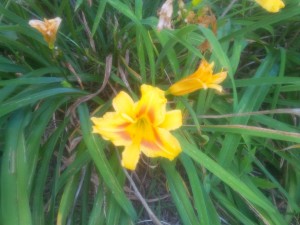
July is daylily time, with slender flower buds bursting open joyfully just as the last of the petals have fallen from the roses and the oak leaf hydrangeas have reached their peak. Though each bloom lasts only one day, the plants are among the toughest around, as well as the most popular. The common, tawny orange type, Hemerocallis fulva, sometimes maligned with the nickname “ditch lily”, thrive wherever they find even a slightly congenial situation. Native to China and Japan and resident in the United States since the late nineteenth century, they have succeeded so well that many people think they are native wildflowers.
But success has a price and the price paid by those “ditch lilies”, which also turn up in gardens, railroad rights-of-way and vacant lots, is that they are considered dangerously invasive in much of the northeast and selected other places across the country. I know all the perils of invasive plants and happily choose natives when I have the chance, but there is still something magical about a steep and otherwise forlorn embankment carpeted with orange blooms.
True lilies belong to the Lilium genus and the Liliaceae family. Daylilies, though they share trumpet-like “lily” blooms, belong to the genus Hemerocallis in the Hemerocallidaceae family. They are most closely related to the amaryllis or Amaryllidaceae plant family and if you examine an amaryllis you can see the similarity in bloom and foliage configuration.
In terms of sheer numbers of cultivated varieties, I think that daylilies probably lead the ornamental plant pack. They are wildly popular, with thousands of registered varieties that bloom in just about every color except true blue. The majority fall into the orange-yellow-peach color range, a situation that led the great garden writer Cassandra Danz to quip, “All daylilies look orange from three feet away.”

Every year breeders introduce new daylilies, which supersede older varieties in the marketplace. Sometimes the newcomers are virtually indistinguishable from their predecessors.
No matter how much space you have in beds, containers or sunny window boxes, there is a daylily that will fit. Dwarf types grow less than 12 inches tall, while more gangly varieties top out at three to four feet. The flowers that bloom atop those stalks–or scapes in daylily lingo—may be miniature, at less than three inches wide, or more than twice that size. A dwarf variety may have large flowers. The opposite is also true.
Regardless of flower size, daylily blooms bear six single petals that can be wide, narrow, edged in “ruffles” or slightly recurved or curled away from the flower’s center. Double-flowered types feature two or more rows of petals, with flowers that sometimes look more like cupcakes than trumpets. This wide variety of flower profiles and plant sizes means that daylilies can fit into almost any landscape scheme, from starkly modern to crammed cottage beds. All they require is plenty of sun and a reasonable amount of water. Well established plants can even withstand some drought.
So how do you choose the right daylily? Local nurseries and garden centers carry relatively few varieties each year, but if you flip through a few catalogs or websites, you can compare colors, bloom types, bloom times and sizes. Old-fashioned daylilies—bred before the last decade of the twentieth century—generally bloom only once per season outside the Deep South. That said, a mature plant may produce scores of buds that open sequentially over a period of a week or ten days. If you select a mixture of early, middle and late season varieties, you can easily enjoy daylily bloom for two months or more. Good vendors supply the “early, middle or late” information on plant tags or in catalog/online descriptions.
Beginning with the first reliable reblooming daylily, the miniature ‘Stella de Oro’, registered in 1985, breeders have produced more and more varieties that will reflower reliably twice or sometimes even three times per growing season. Many of these sport smaller flowers, but they compensate with abundant production and, in most cases, dependability.
An array of daylilies inhabit my premises and the collection includes at least one heirloom variety, some romantic doubles, interesting bi-colors and a many different flower and plant sizes. I don’t divide any of them as often as I should, but if I did, I would have enough plants to fill another garden. My yard is even home to a stand of tawny orange ditch lilies that refuse to do anything except reproduce and bloom. I grub out the overflow from time to time and deadhead to prevent self-seeding. The clumps increase in size no matter what I do.
My favorite of all the daylilies is the old-fashioned “lemon lily” or Hemerocallis flava. Sometimes also known to its botanist friends as Hemerocallis lilioasphodelus, it a tall, once-bloomer that waits until the middle to end of the daylily season to produce flowers. The magic of the yellow blooms is not their cheerful appearance, but their sweet, lemony scent. I have mine by a walkway, so I can smell the fragrance as I pass.
Daylily vendors abound online, but if you have a yen for some of the best plants, try Oakes Daylilies, P.O. Box 268, Corryton, TN 37721; (800) 532-9545; www.oakesdaylilies.com. Free print catalog.

